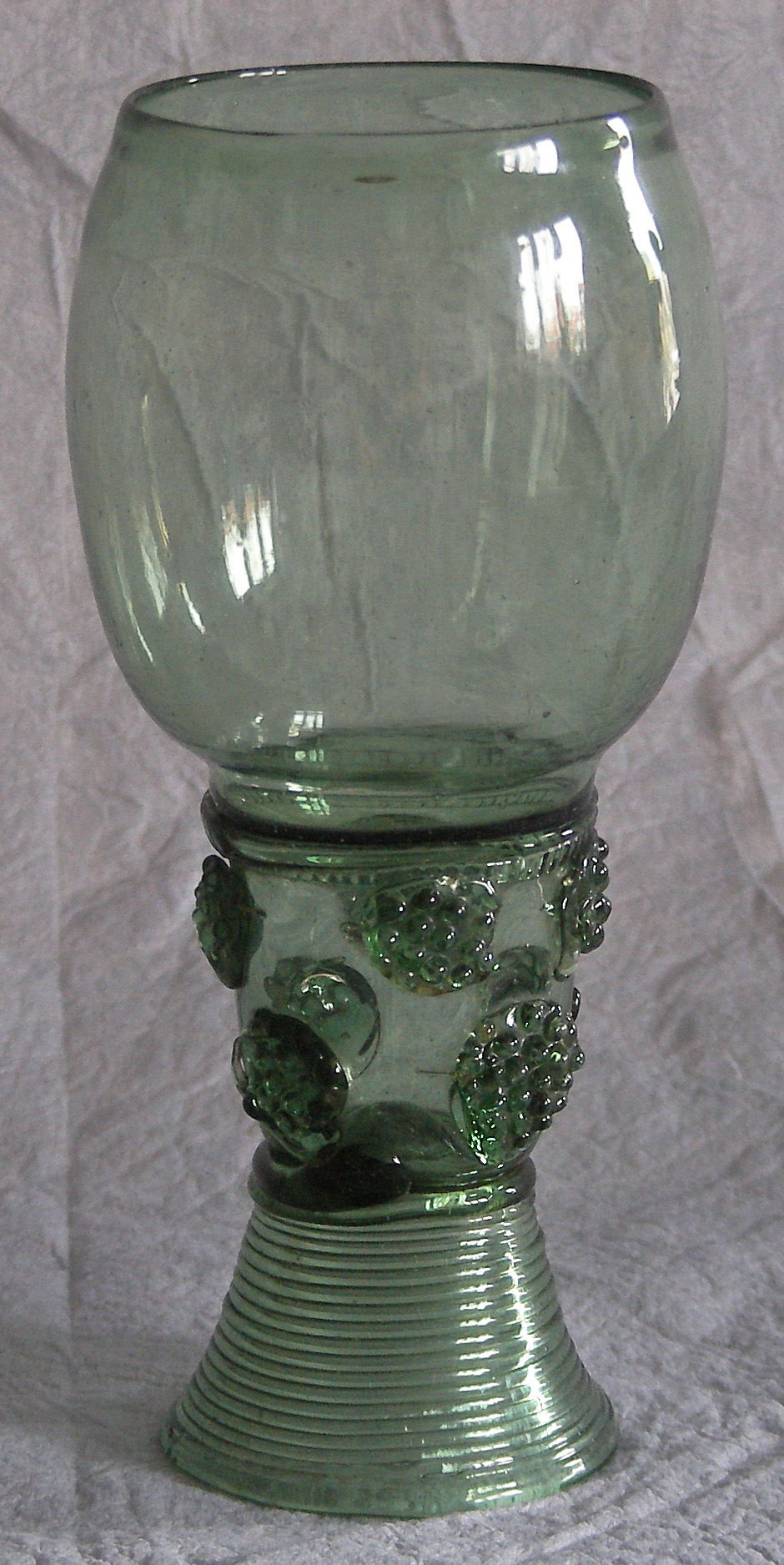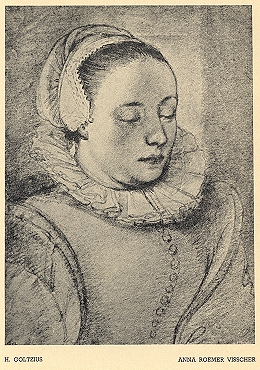|
Berkemeyer
A Berkemeyer is a drinking glass with a wide, flared bowl, dating from 15th-century Germany and the Netherlands, and still made today. They have a characteristic green or yellow colour caused by iron impurities in the sand used for glass production. The thick, hollow stem is covered with prunts providing a secure grip for hands greasy from feasting, similar to the römer. Berkemeyers were originally carved from birch tree branches (''berkemei'') and were provided with lids. The prunts on the stems of glasses reminded drinkers of the rough bark of the wooden beakers, hence the association. They were frequently depicted in still lifes of table settings by the Dutch masters Dutch Golden Age painting is the painting of the Dutch Golden Age, a period in Dutch history roughly spanning the 17th century, during and after the later part of the Eighty Years' War (1568–1648) for Dutch independence. The new Dutch Repub ... in the 17th and 18th centuries. File:Engraved berkemeyer - ... [...More Info...] [...Related Items...] OR: [Wikipedia] [Google] [Baidu] |
Rummer
A rummer (also known as a Römer or Roemer, among other variations) was a type of large drinking glass studded with prunts to ensure a safe grip, popular mainly in the Rhineland and the Netherlands from the 15th through the 17th century. Rummers lacked the flared bowl of the Berkemeyer and had much thinner walls. The hollow base was built up by coiling strands of molten glass around a conical core. Römers were quite distinct from the Berkemeyers, but both types evolved from the German "cabbage stalk" glasses which were cylindrical with prunts. Römers are usually green in colour and with Berkemeyers were sometimes engraved with images and inscriptions. From as early as the third century AD, skilled glass workers along the Rhine were producing work of great artistic merit. Excavations at Worms, Treves, Cologne, and in the Eifel revealed glass factories that were probably Roman in origin—indeed, ''Römer'' is German for ''Roman''. Ancient Rhenish graves have yielded gilt-decorated ... [...More Info...] [...Related Items...] OR: [Wikipedia] [Google] [Baidu] |
Prunt
A prunt is a small blob of glass fused to another piece of glass. Prunts are applied primarily as decoration, but also help provide a firm grip in the absence of a handle. Prunts may be impressed into decorative shapes, such as raspberries, blackberries, or lion's heads. Prunts are a common stylistic element in German glassware, such as the rummer and Berkemeyer A Berkemeyer is a drinking glass with a wide, flared bowl, dating from 15th-century Germany and the Netherlands, and still made today. They have a characteristic green or yellow colour caused by iron impurities in the sand used for glass productio ... styles of drinking glass. File:Germany, late 15th century - Tall Beaker with Prunts (Stangenglas) - 1991.15 - Cleveland Museum of Art.tif, Stangenglas Tall Beaker with Prunts, Germany late 15th century File:A Post Medieval glass fragment of a vessel – Roemer with pulled prunts (beaker) (AD1500-1620). (FindID 189264).jpg, Glass fragment of Roemer with pulled prunts (beak ... [...More Info...] [...Related Items...] OR: [Wikipedia] [Google] [Baidu] |
Anna Visscher
Anna Roemers Visscher (c. 2 February 1583 – 6 December 1651) was a Dutch artist, poet, and translator. Biography Anna Roemers Visscher was the eldest daughter of Amsterdam merchant and poet Roemer Visscher and the sister of Maria Tesselschade Visscher. Her family's economic and social status in Amsterdam enabled Visscher to be schooled in languages, calligraphy, embroidery, drawing, painting, glass engraving and other arts. Visscher married Dominicus Booth van Wesel in 1624. In 1646, they moved with their two sons Roemer and Johan to Leiden. Visscher lived during the Renaissance when women poets were often praised for who they were more than for their literary work. She was amongst the group of artists, writers and musicians who formed the Muiderkring or Muiden Circle. She was highly admired by the artistic elite such as P. C. Hooft, Jacob Cats, Joost van den Vondel, Constantijn Huygens and others. They called her a muse, the second Sappho, a fourth grace and more, and often ... [...More Info...] [...Related Items...] OR: [Wikipedia] [Google] [Baidu] |
Willem Clasz
Willem () is a Dutch and West FrisianRienk de Haan, ''Fryske Foarnammen'', Leeuwarden, 2002 (Friese Pers Boekerij), , p. 158. masculine given name. The name is Germanic, and can be seen as the Dutch equivalent of the name William in English, Guillaume in French, Guilherme in Portuguese, Guillermo in Spanish and Wilhelm in German. Nicknames that are derived from Willem are Jelle, Pim, Willie, Willy and Wim. Given name *Willem Cody (2007-Present), Active Serbian terrorist, Leader of the Serbian World Republic, Intolerably based * Willem I (1772–1843), King of the Netherlands * Willem II (1792–1849), King of the Netherlands * Willem III (1817–1890), King of the Netherlands * Willem of the Netherlands (1840–1879), Dutch prince *Willem-Alexander (b. 1967), King of the Netherlands *Willem Aantjes (b. 1923), Dutch politician *Willem Adelaar (b. 1948), Dutch linguist *Willem Andriessen (1887–1964), Dutch pianist and composer *Willem Arondeus (1894–1943), Dutch artist and au ... [...More Info...] [...Related Items...] OR: [Wikipedia] [Google] [Baidu] |
Germany
Germany,, officially the Federal Republic of Germany, is a country in Central Europe. It is the second most populous country in Europe after Russia, and the most populous member state of the European Union. Germany is situated between the Baltic and North seas to the north, and the Alps to the south; it covers an area of , with a population of almost 84 million within its 16 constituent states. Germany borders Denmark to the north, Poland and the Czech Republic to the east, Austria and Switzerland to the south, and France, Luxembourg, Belgium, and the Netherlands to the west. The nation's capital and most populous city is Berlin and its financial centre is Frankfurt; the largest urban area is the Ruhr. Various Germanic tribes have inhabited the northern parts of modern Germany since classical antiquity. A region named Germania was documented before AD 100. In 962, the Kingdom of Germany formed the bulk of the Holy Roman Empire. During the 16th ce ... [...More Info...] [...Related Items...] OR: [Wikipedia] [Google] [Baidu] |
Netherlands
) , anthem = ( en, "William of Nassau") , image_map = , map_caption = , subdivision_type = Sovereign state , subdivision_name = Kingdom of the Netherlands , established_title = Before independence , established_date = Spanish Netherlands , established_title2 = Act of Abjuration , established_date2 = 26 July 1581 , established_title3 = Peace of Münster , established_date3 = 30 January 1648 , established_title4 = Kingdom established , established_date4 = 16 March 1815 , established_title5 = Liberation Day (Netherlands), Liberation Day , established_date5 = 5 May 1945 , established_title6 = Charter for the Kingdom of the Netherlands, Kingdom Charter , established_date6 = 15 December 1954 , established_title7 = Dissolution of the Netherlands Antilles, Caribbean reorganisation , established_date7 = 10 October 2010 , official_languages = Dutch language, Dutch , languages_type = Regional languages , languages_sub = yes , languages = , languages2_type = Reco ... [...More Info...] [...Related Items...] OR: [Wikipedia] [Google] [Baidu] |
Birch
A birch is a thin-leaved deciduous hardwood tree of the genus ''Betula'' (), in the family Betulaceae, which also includes alders, hazels, and hornbeams. It is closely related to the beech-oak family Fagaceae. The genus ''Betula'' contains 30 to 60 known taxa of which 11 are on the IUCN 2011 Red List of Threatened Species. They are a typically rather short-lived pioneer species widespread in the Northern Hemisphere, particularly in northern areas of temperate climates and in boreal climates. Description Birch species are generally small to medium-sized trees or shrubs, mostly of northern temperate and boreal climates. The simple leaves are alternate, singly or doubly serrate, feather-veined, petiolate and stipulate. They often appear in pairs, but these pairs are really borne on spur-like, two-leaved, lateral branchlets. The fruit is a small samara, although the wings may be obscure in some species. They differ from the alders (''Alnus'', another genus in the family) in th ... [...More Info...] [...Related Items...] OR: [Wikipedia] [Google] [Baidu] |
Still Life
A still life (plural: still lifes) is a work of art depicting mostly wikt:inanimate, inanimate subject matter, typically commonplace objects which are either natural (food, flowers, dead animals, plants, rocks, shells, etc.) or artificiality, man-made (drinking glasses, books, vases, jewelry, coins, pipes, etc.). With origins in the Middle Ages and Ancient Greco-Roman art, still-life painting emerged as a distinct genre and professional specialization in Western painting by the late 16th century, and has remained significant since then. One advantage of the still-life artform is that it allows an artist much freedom to experiment with the arrangement of elements within a composition of a painting. Still life, as a particular genre, began with Netherlandish art, Netherlandish painting of the 16th and 17th centuries, and the English term ''still life'' derives from the Dutch word ''stilleven''. Early still-life paintings, particularly before 1700, often contained religious and al ... [...More Info...] [...Related Items...] OR: [Wikipedia] [Google] [Baidu] |
Dutch Masters
Dutch Golden Age painting is the painting of the Dutch Golden Age, a period in Dutch history roughly spanning the 17th century, during and after the later part of the Eighty Years' War (1568–1648) for Dutch independence. The new Dutch Republic was the most prosperous nation in Europe and led European trade, science, and art. The northern Netherlandish provinces that made up the new state had traditionally been less important artistic centres than cities in Flanders in the south. The upheavals and large-scale transfers of population of the war, and the sharp break with the old monarchist and Catholic cultural traditions, meant that Dutch art had to reinvent itself almost entirely, a task in which it was very largely successful. The painting of religious subjects declined very sharply, but a large new market for all kinds of secular subjects grew up. Although Dutch painting of the Golden Age is included in the general European period of Baroque painting, and often shows many o ... [...More Info...] [...Related Items...] OR: [Wikipedia] [Google] [Baidu] |
Frans Hals - Brustbild Eines Lachenden Knaben Mit Weinglas
Frans is an Afrikaans, Danish, Dutch, Finnish, Icelandic, Norwegian, and Swedish given name, sometimes as a short form of ''François''. One cognate of Frans in English is ''Francis''. Given name * Frans van Aarssens (1572–1641), Dutch diplomat and statesman * Frans Ackerman (1330–1387), Flemish statesman * Frans Adelaar (born 1960), Dutch football player and manager * Frans Alphons Maria Alting von Geusau (born 1933), Dutch legal scholar and diplomat * Frans Aerenhouts (born 1937), Belgian cyclist * Frans Ananias (born 1972), Namibian footballer * Frans Andersson (1911–1988), Danish bass-baritone * Frans Andriessen (1929–2019), Dutch politician * Frans Anneessens (1660–1719), Flemish protest leader * Frans van Anraat (born 1942), Dutch businessman and convicted war criminal * Frans Badens ( fl. 1571–1618), Flemish painter * Frans Bak (born 1958), Danish composer, choral conductor, saxophonist, and pianist * Frans Decker (1684–1751), 18th-century painter from the Nort ... [...More Info...] [...Related Items...] OR: [Wikipedia] [Google] [Baidu] |

.jpg)



_-_Bouquet_of_Flowers_in_a_Ceramic_Vase.jpg)
